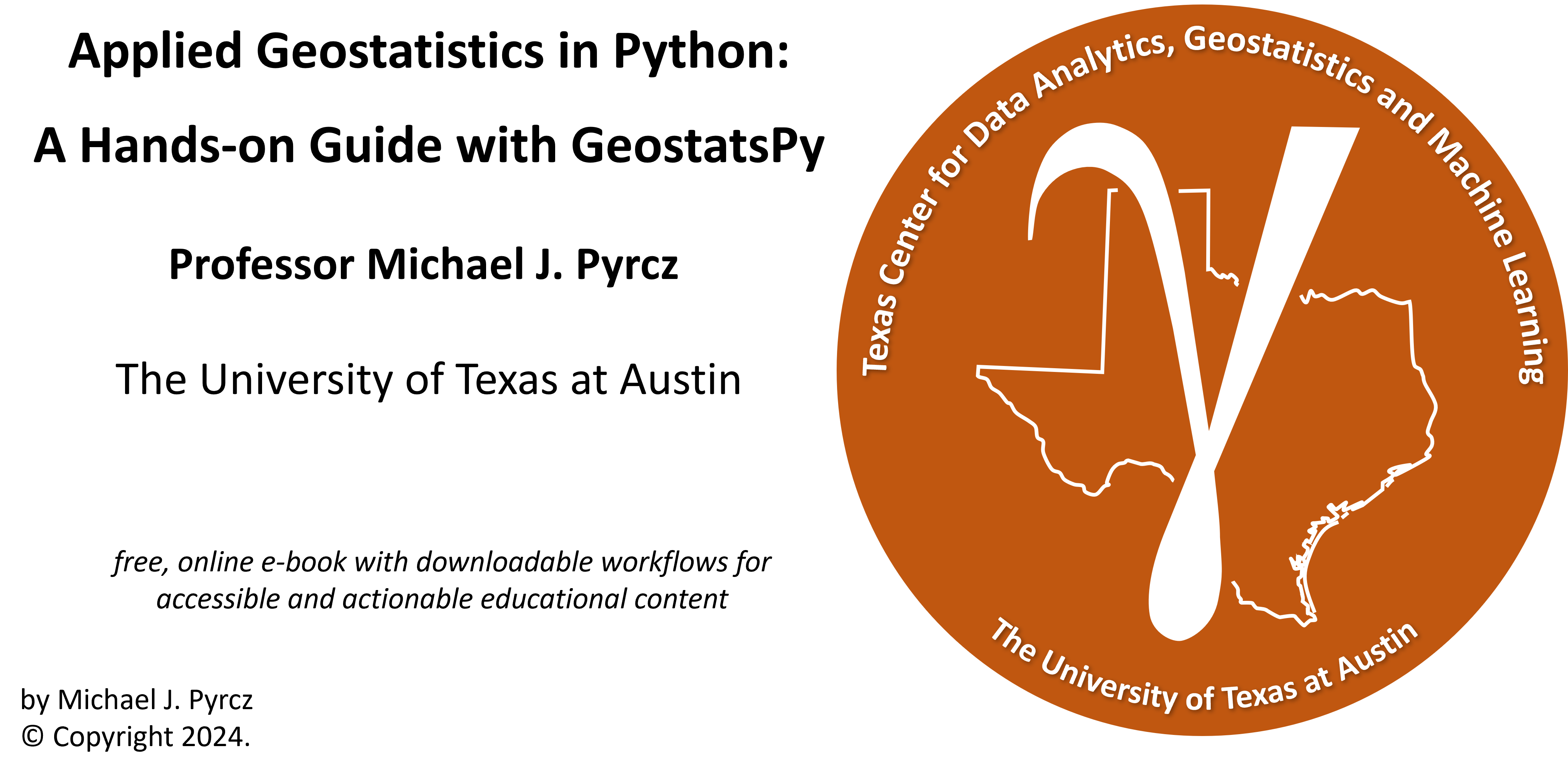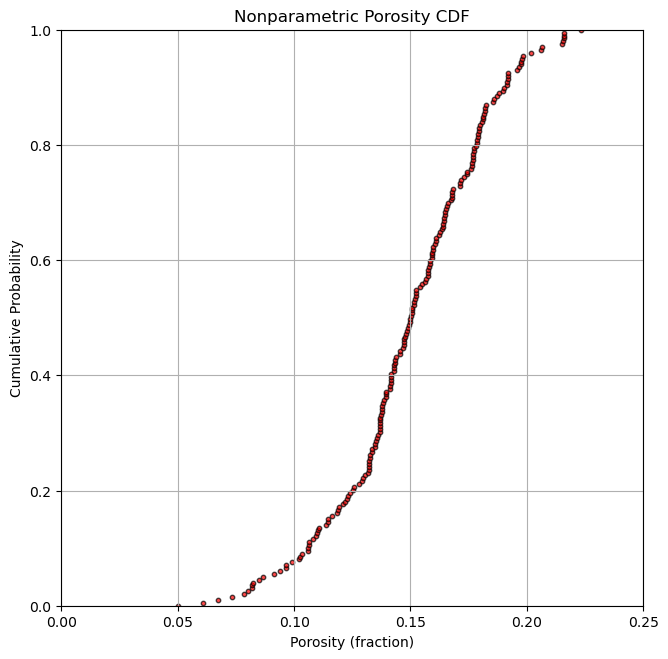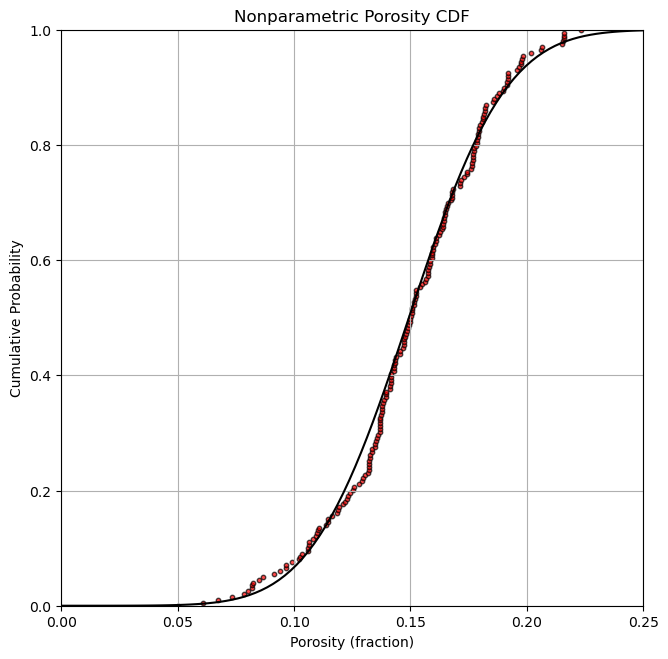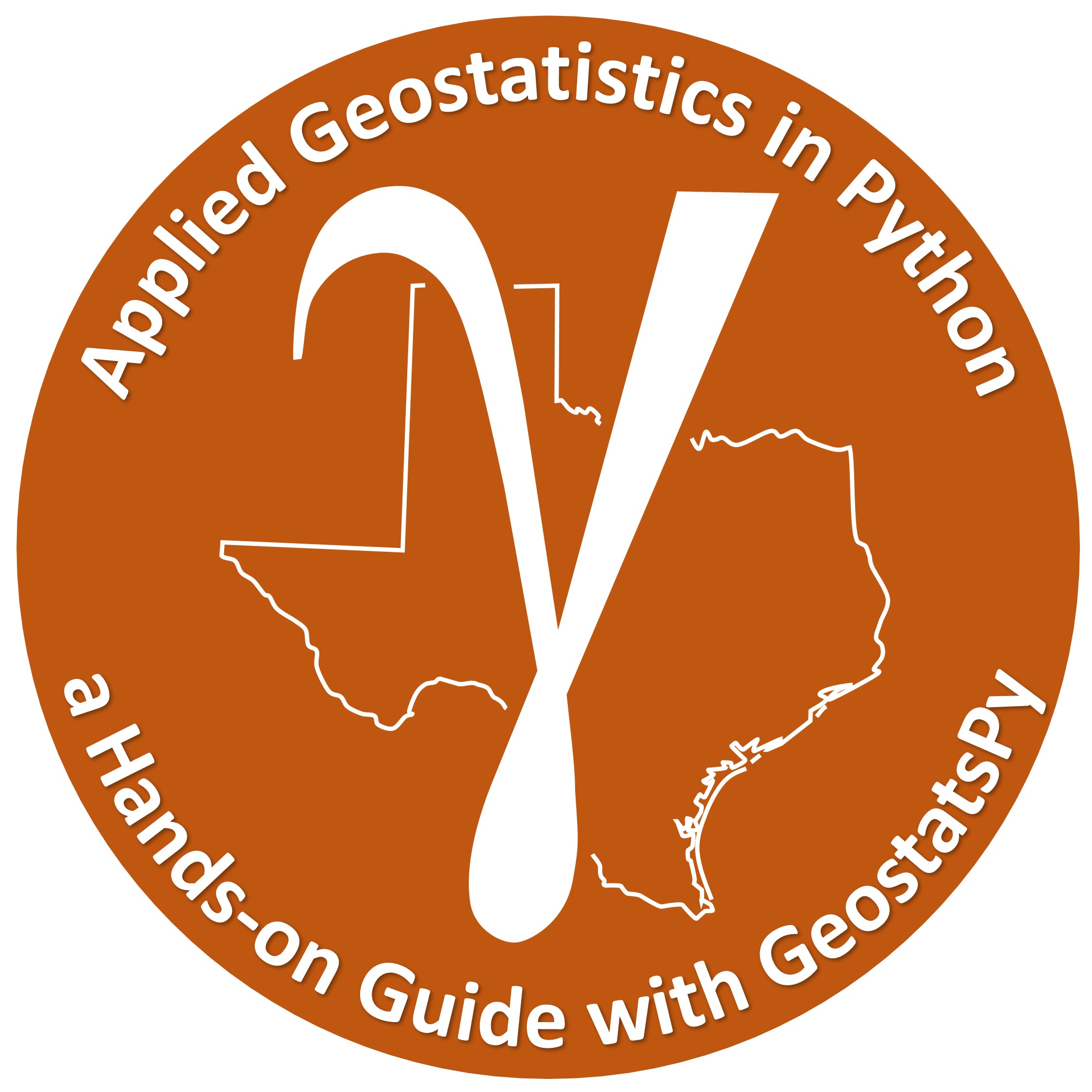
Univariate Statistics#
Michael J. Pyrcz, Professor, The University of Texas at Austin
Twitter | GitHub | Website | [GoogleScholar](https://Twitter | GitHub | Website | GoogleScholar | Geostatistics Book | YouTube | Applied Geostats in Python e-book | Applied Machine Learning in Python e-book | LinkedIn
Chapter of e-book “Applied Geostatistics in Python: a Hands-on Guide with GeostatsPy”.
Cite this e-Book as:
Pyrcz, M.J., 2024, Applied Geostatistics in Python: a Hands-on Guide with GeostatsPy [e-book]. Zenodo. doi:10.5281/zenodo.15169133
The workflows in this book and more are available here:
Cite the GeostatsPyDemos GitHub Repository as:
Pyrcz, M.J., 2024, GeostatsPyDemos: GeostatsPy Python Package for Spatial Data Analytics and Geostatistics Demonstration Workflows Repository (0.0.1) [Software]. Zenodo. doi:10.5281/zenodo.12667036. GitHub Repository: GeostatsGuy/GeostatsPyDemos
By Michael J. Pyrcz
© Copyright 2024.
This chapter is a tutorial for / demonstration of Univariate Statistics.
YouTube Lecture: check out my lecture on Univariate Statistics. For your convenience here’s a summary of salient points.
Here’s a demonstration of calculation of univariate statistics in Python. This demonstration is part of the resources that I include for my courses in Spatial / Subsurface Data Analytics and Geostatistics at the Cockrell School of Engineering and Jackson School of Goesciences at the University of Texas at Austin.
We will cover the following statistics:
Measures of Centrality#
Arithmetic Average / Mean
Median
Mode (most frequent binned)
Geometric Mean
Harmonic Mean
Power Law Average
Measures of Dispersion#
Population Variance
Sample Variance
Population Standard Deviation
Sample Standard Deviation
Range
Percentile w. Tail Assumptions
Interquartile Range
Tukey Outlier Test#
Lower Quartile/P25
Upper Quartile/P75
Interquartile Range
Lower Fence
Upper Fence
Calculating Outliers
Measures of Shape#
Skew
Excess Kurtosis
Pearson’ Mode Skewness
Quartile Skew Coefficient
Nonparmetric Cumulative Distribution Functions (CDFs)#
plotting a nonparametric CDF
fitting a parametric distribution and plotting
Load the Required Libraries#
The following code loads the required libraries. These should have been installed with Anaconda 3.
import numpy as np # ndarrys for gridded data
import pandas as pd # DataFrames for tabular data
import os # set working directory, run executables
import matplotlib.pyplot as plt # plotting
import scipy # statistics
import statistics as stats # statistics like the mode
from scipy.stats import norm # fitting a Gaussian distribution
Set the Working Directory#
I always like to do this so I don’t lose files and to simplify subsequent read and writes (avoid including the full address each time). Set this to your working directory, with the above mentioned data file.
#os.chdir("c:/PGE383") # set the working directory
Loading Tabular Data#
Let’s load the provided multivariate, spatial dataset 2D_MV_200wells.csv available in my GeoDataSet repo. It is a comma delimited file with:
X coordinate (m)
Y coordinate (m)
facies_threshold_0.3 facies (1 - shale, 2 - sand)
porosity (%)
permeability (\(mD\))
acoustic impedance (\(\frac{kg}{m^3} \cdot \frac{m}{s} \cdot 10^6\)).
We load it with the pandas ‘read_csv’ function into a data frame we called ‘df’ and then preview it to make sure it loaded correctly.
df = pd.read_csv("https://raw.githubusercontent.com/GeostatsGuy/GeoDataSets/master/2D_MV_200wells.csv") # read a .csv file in as a DataFrame
#print(df.iloc[0:5,:]) # display first 4 samples in the table as a preview
df.head(n=13) # we could also use this command for a table preview
| X | Y | facies_threshold_0.3 | porosity | permeability | acoustic_impedance | |
|---|---|---|---|---|---|---|
| 0 | 565 | 1485 | 1 | 0.1184 | 6.1700 | 2.009 |
| 1 | 2585 | 1185 | 1 | 0.1566 | 6.2750 | 2.864 |
| 2 | 2065 | 2865 | 2 | 0.1920 | 92.2970 | 3.524 |
| 3 | 3575 | 2655 | 1 | 0.1621 | 9.0480 | 2.157 |
| 4 | 1835 | 35 | 1 | 0.1766 | 7.1230 | 3.979 |
| 5 | 3375 | 2525 | 1 | 0.1239 | 1.4680 | 2.337 |
| 6 | 2295 | 1325 | 1 | 0.1790 | 31.9330 | 3.491 |
| 7 | 3715 | 3045 | 2 | 0.1914 | 116.7810 | 2.187 |
| 8 | 2865 | 2215 | 1 | 0.1763 | 3.0030 | 2.048 |
| 9 | 55 | 1545 | 1 | 0.1674 | 5.2130 | 2.251 |
| 10 | 2125 | 1105 | 1 | 0.1369 | 3.6930 | 3.627 |
| 11 | 565 | 195 | 1 | 0.1095 | 0.2627 | 2.860 |
| 12 | 3475 | 1035 | 1 | 0.1677 | 9.9140 | 2.742 |
Let’s extract one of the features, porosity, into a 1D ndarray and do our statistics on porosity.
then we can use NumPy’s statistics methods
por = df['porosity'].values # extract porosity feature as a NumPy ndarray
Check the output from the above.
print('por is a ' + str(type(por)) + ', with shape of ' + str(por.shape)) # check the type and size
por is a <class 'numpy.ndarray'>, with shape of (200,)
Now let’s go through all the univariate statistics listed above one-by-one.
Measures of Central Tendency#
Let’s start with measures of central tendency.
The Arithmetic Average / Mean#
\begin{equation} \overline{x} = \frac{1}{n}\sum^n_{i=1} x_i \end{equation}
por_average = np.average(por)
print('Porosity average is ' + str(round(por_average,2)) + '.')
Porosity average is 0.15.
Median#
\begin{equation} P50_x = F^{-1}_{x}(0.50) \end{equation}
por_median = np.median(por)
print('Porosity median is ' + str(round(por_median,2)) + '.')
Porosity median is 0.15.
Mode#
The most common value. To do this we should bin the data, like into histogram bins/bars. To do this we will round the data to the 2nd decimal place. We are assume bin boundaries, \(0.01, 0.02,\ldots, 0.30\).
por_mode = stats.mode(np.round(por,2))
print('Porosity mode is ' + str(round(por_mode,2)) + '.')
Porosity mode is 0.14.
Geometric Mean#
\begin{equation} \overline{x}G = ( \prod^n{i=1} x_i )^{\frac{1}{n}} \end{equation}
por_geometric = scipy.stats.mstats.gmean(por)
print('Porosity geometric mean is ' + str(round(por_geometric,2)) + '.')
Porosity geometric mean is 0.15.
Harmonic Mean#
\begin{equation} \overline{x}H = \frac{n}{\sum^n{i=1} \frac{1}{x_i}} \end{equation}
por_hmean = scipy.stats.mstats.hmean(por)
print('Porosity harmonic mean is ' + str(round(por_hmean,2)) + '.')
Porosity harmonic mean is 0.14.
Power Law Average#
\begin{equation} \overline{x}p = (\frac{1}{n}\sum^n{i=1}{x_i^{p}})^\frac{1}{p} \end{equation}
p = 1.0
por_power = np.average(np.power(por,p))**(1/p)
print('Porosity law mean for p = ' + str(p) + ' is ' + str(round(por_power,2)) + '.')
Porosity law mean for p = 1.0 is 0.15.
p = 1.0
np.power(por,p).shape
(200,)
Measures of Dispersion#
Population Variance#
\begin{equation} \sigma^2_{x} = \frac{1}{n}\sum^n_{i=1}(x_i - \mu) \end{equation}
por_varp = stats.pvariance(por)
print('Porosity population variance is ' + str(round(por_varp,4)) + '.')
Porosity population variance is 0.0011.
Sample Variance#
\begin{equation} \sigma^2_{x} = \frac{1}{n-1}\sum^n_{i=1}(x_i - \overline{x})^2 \end{equation}
por_var = stats.variance(por)
print('Porosity sample variance is ' + str(round(por_var,4)) + '.')
Porosity sample variance is 0.0011.
Population Standard Deviation#
\begin{equation} \sigma_{x} = \sqrt{ \frac{1}{n}\sum^n_{i=1}(x_i - \mu)^2 } \end{equation}
por_stdp = stats.pstdev(por)
print('Porosity sample standard deviation is ' + str(round(por_stdp,4)) + '.')
Porosity sample standard deviation is 0.0329.
Sample Standard Deviation#
\begin{equation} \sigma_{x} = \sqrt{ \frac{1}{n-1}\sum^n_{i=1}(x_i - \mu)^2 } \end{equation}
por_std = stats.stdev(por)
print('Porosity sample variance is ' + str(round(por_std,4)) + '.')
Porosity sample variance is 0.0329.
Range#
\begin{equation} range_x = P100_x - P00_x \end{equation}
por_range = np.max(por) - np.min(por)
print('Porosity range is ' + str(round(por_range,2)) + '.')
Porosity range is 0.17.
Percentile#
\begin{equation} P(p)x = F^{-1}{x}(p) \end{equation}
p_value = 13
por_percentile = np.percentile(por,p_value)
print('Porosity ' + str(int(p_value)) + 'th percentile is ' + str(round(por_percentile,2)) + '.')
Porosity 13th percentile is 0.11.
Inter Quartile Range#
\begin{equation} IQR = P(0.75)_x - P(0.25)_x \end{equation}
por_iqr = scipy.stats.iqr(por)
print('Porosity interquartile range is ' + str(round(por_iqr,2)) + '.')
Porosity interquartile range is 0.04.
Cumulative Probability#
Given a value, calculate the forward of the CDF,
In the case of nonparametric distribution, this may be approximated by sorting a list and finding the number of values less than the value.
a more robust method is to fit the CDF and use the parametric CDF expression of nonparametric CDF with interpolation
value = 0.13 # select a value to calculate the cumulative probability
np.sort(por)
rank = np.sum(por <= value)
cumulative_prob = rank / len(por)
print('Cumulative probability of porosity = ' + str(value) + ' is ' + str(round(cumulative_prob,2)) + '.')
Cumulative probability of porosity = 0.13 is 0.22.
Tukey Test for Outliers#
Let’s demonstrate the Tukey test for outliers based on the lower and upper fences.
\begin{equation} fence_{lower} = P_x(0.25) - 1.5 \times [P_x(0.75) - P_x(0.25)] \end{equation}
\begin{equation} fence_{upper} = P_x(0.75) + 1.5 \times [P_x(0.75) - P_x(0.25)] \end{equation}
Then we declare samples values above the upper fence or below the lower fence as outliers.
p25, p75 = np.percentile(por, [25, 75])
lower_fence = p25 - por_iqr * 1.5
upper_fence = p75 + por_iqr * 1.5
por_outliers = por[np.where((por > upper_fence) | (por < lower_fence))[0]]
print('Porosity outliers by Tukey test include ' + str(por_outliers) + '.')
por_outliers_indices = np.where((por > upper_fence) | (por < lower_fence))[0]
print('Porosity outlier indices by Tukey test are ' + str(por_outliers_indices) + '.')
Porosity outliers by Tukey test include [0.06726 0.05 0.06092].
Porosity outlier indices by Tukey test are [110 152 198].
Measures of Shape#
Pearson’s Mode Skewness#
\begin{equation} skew = \frac{3 (\overline{x} - mode_x)}{\sigma_x} \end{equation}
por_skew = (por_average - por_mode)/por_std
print('Porosity skew is ' + str(round(por_skew,2)) + '.')
Porosity skew is 0.28.
Population Skew, 3rd Central Moment#
\begin{equation} \gamma_{x} = \frac{1}{n}\sum^n_{i=1}(x_i - \mu)^3 \end{equation}
por_cm = scipy.stats.moment(por,moment=3)
print('Porosity 3rd central moment is ' + str(round(por_cm,7)) + '.')
Porosity 3rd central moment is -1.22e-05.
Quartile Skew Coefficient#
\begin{equation} QS = \frac{(P75_x - P50_x) - (P50_x - P25_x)}{(P75_x - P25_x)} \end{equation}
por_qs = ((np.percentile(por,75)-np.percentile(por,50))
-(np.percentile(por,50)-np.percentile(por,25))) /((np.percentile(por,75))-np.percentile(por,25))
print('Porosity quartile skew coefficient is ' + str(round(por_qs,2)) + '.')
Porosity quartile skew coefficient is 0.14.
Plot the Nonparametric CDF#
Let’s demonstrate plotting a nonparametric cumulative distribution function (CDF) in Python
# sort the data:
por_sort = np.sort(por)
# calculate the cumulative probabilities assuming known tails
p = np.arange(len(por)) / (len(por) - 1)
# plot the cumulative probabilities vs. the sorted porosity values
plt.subplot(122)
plt.scatter(por_sort, p, c = 'red', edgecolors = 'black', s = 10, alpha = 0.7)
plt.xlabel('Porosity (fraction)'); plt.ylabel('Cumulative Probability'); plt.grid();
plt.title('Nonparametric Porosity CDF')
plt.ylim([0,1]); plt.xlim([0,0.25])
plt.subplots_adjust(left=0.0, bottom=0.0, right=2.0, top=1.2, wspace=0.2, hspace=0.3)

Fit a Gaussian Distribution#
Let’s fit a Gaussian distribution
we get fancy with Maximuum Likelihood Estimation (MLE) for the Gaussian parametric distribution fit mean and standard deviation
por_values = np.linspace(0.0,0.25,100)
fit_mean, fit_stdev = norm.fit(por,loc = por_average, scale = por_std) # fit MLE of the distribution
cumul_p = norm.cdf(por_values, loc = fit_mean, scale = fit_stdev)
# plot the cumulative probabilities vs. the sorted porosity values
plt.subplot(122)
plt.scatter(por_sort, p, c = 'red', edgecolors = 'black', s = 10, alpha = 0.7)
plt.plot(por_values,cumul_p, c = 'black')
plt.xlabel('Porosity (fraction)'); plt.ylabel('Cumulative Probability'); plt.grid();
plt.title('Nonparametric Porosity CDF')
plt.ylim([0,1]); plt.xlim([0,0.25])
plt.subplots_adjust(left=0.0, bottom=0.0, right=2.0, top=1.2, wspace=0.2, hspace=0.3)

Want to Work Together?#
I hope this content is helpful to those that want to learn more about subsurface modeling, data analytics and machine learning. Students and working professionals are welcome to participate.
Want to invite me to visit your company for training, mentoring, project review, workflow design and / or consulting? I’d be happy to drop by and work with you!
Interested in partnering, supporting my graduate student research or my Subsurface Data Analytics and Machine Learning consortium (co-PI is Professor John Foster)? My research combines data analytics, stochastic modeling and machine learning theory with practice to develop novel methods and workflows to add value. We are solving challenging subsurface problems!
I can be reached at mpyrcz@austin.utexas.edu.
I’m always happy to discuss,
Michael
Michael Pyrcz, Ph.D., P.Eng. Professor, Cockrell School of Engineering and The Jackson School of Geosciences, The University of Texas at Austin
More Resources Available at: Twitter | GitHub | Website | GoogleScholar | Geostatistics Book | YouTube | Applied Geostats in Python e-book | Applied Machine Learning in Python e-book | LinkedIn


Comments#
This was a basic demonstration of univariate statistics in Python. Much more can be done, I have other demonstrations for modeling workflows with GeostatsPy in the GitHub repository GeostatsPy_Demos.
I hope this is helpful,
Michael
I hope this was helpful,
Michael